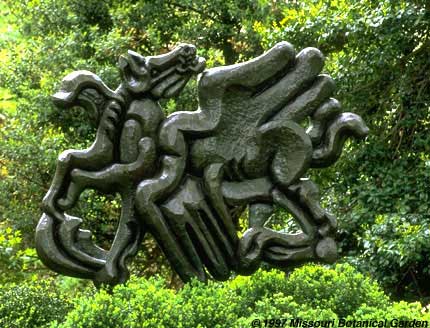

Birth of the Muses(1887)
Bronze, 60 x 89 inches.
Bequest by the Late Mrs. Gertrude T. Bernoudy in memory of her husband William A. Bernoudy in 1994. The sculpture stood in the garden at the Bernoudy's St. Louis home for many years.
![]()
Artist:
Jacques Lipchitz
Lithuanian (1891-1973)
Chaim Jacob Lipchitz, 1891-1973, was born in Lithuania and came of age in Paris during the early 20th century, where he was active in the avante-garde community of Picasso, Modigliani, Rivera, Soutine, and Gris. Art historian H. H. Arnasson, who ranked Lipchitz with Picasso and Chagall, wrote, "Lipchitz, as a pure sculptor, is ...unquestionably one of the greatest sculptors of this century."
Lipchitz' work is familiar to St. Louisans; his monumental 1927 bronze Joie de Vivre (a gift of Mrs. Mark C. Steinberg) is displayed at the Steinberg Skating Rink in Forest Park. The St. Louis Art Museum loaned two of Lipchitz' works, the 1923-25 Large Bather (gift of Morton D. May) and the 1926-30 Figure (gift of Mr. and Mrs. Joseph Pulitzer) to the St. Louis Bicentennial Sculpture Exhibition at the Garden in 1985. The exhibition also included a 1940 Lipchitz' Mother and Child from an anonymous donor. The 1926-30 Figure was displayed at the Garden again for the Spring Sculpture Festival in 1972.
The Bernoudy sculpture is based on designs Lipchitz created during the 1940s. The architect Philip Johnson asked Lipchitz to make a wall sculpture to be placed on the brick chimney over a fireplace of a guest house owned by Mrs. John D. Rockefeller III on West 53rd Street in New York. Lipchitz decided to develop the piece from his Pegasus designs and call it Birth of the Muses in honor of the Rockefellers' interest in the arts. In 1950 he completed the work as a bronze relief five feet high. It was installed as planned and later was acquired by Lincoln Center. The Bernoudy sculpture is similar in design to the Rockefeller piece.
Lipchitz' interpretation of the theme took some artistic
license with Greek mythology. The sculpture conceived of Pegasus striking
his hoofs on rock on Mount Olympus, and the muses being born in four springs
that emerged from that contact. In the original legend, Pegasus stamped
a hoof on Mount Helicon in Boeotia, making the Hippocrene Spring, where
the already born nine muses, daughters of Zeus and Mnemosyne, goddess of
memory, disported themselves in their sacred grove around the spring.
![]()
Location:
Southeast of the Climatron® near the Knolls
![]()
Birth of the Muses (Pegasus)
In the Greek Myth of Pegasus, the goddess Athena gave Pegasus, a beautiful winged horse, to the nine Muses. With a stroke of his hoof he caused the poetically inspiring fountain Hippocrene to well forth on Mount Helicon.
When a young hero named Bellerophon was sent on dangerous missions by King Iobates, he asked a seer how to capture the winged horse. The seer advised him to sleep in the temple of Athena. After dreaming of the goddess, Bellerophon awoke and found a golden bridle beside him. With this he captured and tamed the magical horse. Flying on Pegasus, Bellerophon destroyed the fire-breathing monster Chimera, defeated the Amazons, and beat off a band of pirates.
The King then gave Bellerophon his daughter in marriage and in time the young hero succeeded to the throne.
After years of happiness, success went to Bellerophon's head and he conceived the idea of riding Pegasus to Mount Olympus, home of the gods. Angered by such arrogance, Zeus sent a gadfly (huge fly) to sting Pegasus in midair. The horse reared in pain and Bellerophon crashed to earth. Crippled and disgraced, he roamed the earth alone until he died.
Pegasus flew on to Olympus, where he became a pack horse
of Zeus carrying the god's thunderbolts. Eventually, his image was placed
among the stars as a constellation.
*From material prepared by George McCue
![]()